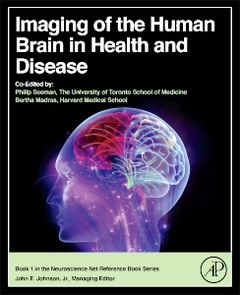Description
Imaging of the Human Brain in Health and Disease
Coordinators: Seeman Philip, Madras Bertha
Language: English
Subject for Imaging of the Human Brain in Health and Disease:
Keywords
ADHD; Acetylcholine receptors; Addiction; Alzheimer's disease; Anger; Autism spectrum disorders; Brain; Brain imaging; CNS Biomarker; Cannabinoid system; Dopamine; Dopamine D3 receptor; Dopamine receptors; Dopamine transporter; Dopamine transporters; Drug Development; Gamma-aminobutyric acid (GABA); Glutamate positron emission tomography (PET); Human Brain; Human Brain Imaging; Human brain; Human brain imaging; Imaging; Imaging marker; Lewy body; MRI; NMR; Neuroimaging; Nigrostriatal; Nondopamine tracers; Opioid Receptors; PET; Parkinson; Parkinson's disease; Positron emission tomography; Radiotracers; SPECT; Serotonin; Sigma receptors; Single-photon emission computer tomography; Tracer
532 p. · 19x23.3 cm · Hardback
Description
/li>Contents
/li>Readership
/li>Biography
/li>Comment
/li>
Brain imaging technology remains at the forefront of advances in both our understanding of the brain and our ability to diagnose and treat brain disease and disorders. Imaging of the Human Brain in Health and Disease examines the localization of neurotransmitter receptors in the nervous system of normal, healthy humans and compares that with humans who are suffering from various neurologic diseases.
Opening chapters introduce the basic science of imaging neurotransmitters, including sigma, acetylcholine, opioid, and dopamine receptors. Imaging the healthy and diseased brain includes brain imaging of anger, pain, autism, the release of dopamine, the impact of cannabinoids, and Alzheimer's disease.
This book is a valuable companion to a wide range of scholars, students, and researchers in neuroscience, clinical neurology, and psychiatry, and provides a detailed introduction to the application of advanced imaging to the treatment of brain disorders and disease.
Chapter 1: Neuroimaging of Addiction – N. Volkow
Chapter 2: Brain PET Imaging in the Cannabinoid System - Wong et al.
Chapter 3: Brain Imaging of Cannabinoid Receptors - Casteels et al.
Chapter 4: Human Brain Imaging of Opioid Receptors: Application to CNS Biomarker and Drug Development - Udi E. Ghitza
Chapter 5: Brain Imaging of Sigma Receptors - Sakata et al.
Chapter 6: Human Brain Imaging of Acetylcholine Receptors - Toyohara et al.
Chapter 7: Human Brain Imaging of Adenosine Receptors - Mishina et al.
Chapter 8: Human Brain Imaging of Dopamine D1 Receptors - Fujiwara et al.
Chapter 9: Human Brain Imaging of Dopamine Transporters - Varrone et al.
Chapter 10: Imaging of Dopamine and Serotonin Receptors and Transporters - Felicio et al.
Chapter 11: Imaging the Dopamine D3 Receptor In Vivo - Slifstein et al.
Chapter 12: Dopamine Receptors and Dopamine Release - R. Kessler
Chapter 13: Dopamine Receptor Imaging in Schizophrenia: Focus on Genetic Vulnerability - Hirvonen et al.
Chapter 14: Human Brain Imaging In Tardive Dyskinesia - Chatziioannou et al.
Chapter 15: Human Brain Imaging of Autism Spectrum Disorders - Brasic et al.
Chapter 16: Radiotracers Used to Image the Brains of Patients with Alzheimer ’s Disease - George et al.
Chapter 17: Human Brain Imaging of Anger - Ghaznavi et al.
Chapter 18: Imaging Pain in the Human Brain - Loggia et al.
Chapter 19: Imaging of Neurochemical Transmission in the Central Nervous System - Deuitch et al.
Chapter 20: Characterizing Recovery of the Human Brain following Stroke: Evidence from fMRI Studies - La et al.
Neuroscience, Neurology, Psychiatry
He has trained over 100 graduate students and Fellows. He is a Fellow of the Royal Society of Canada. He has received 25 awards, including the Lieber Award of NARSAD (the National Alliance for Research in Schizophrenia and Depression), the Lifetime Achievement Award of the Society for Biological Psychiatry, the Ariens Receptor award of the Dutch Pharmacology Society, the Stanley Dean Award of the American College of Psychiatrists, the first Prix Galien award in North America, the Pasarow Foundation award in Neuropsychiatry, the Canada Council Killam Prize, and the Order of Canada. He has written approximately 750 publications.
Dr. Madras is Professor of Psychobiology at Harvard Medical School (HMS), is cross-appointed at the Massachusetts General Hospital and founded the Division of Neurochemistry at the HMS Primate Center. She served as Deputy Director for Demand Reduction in the White House Office of National Drug Control Policy (ONDCP), a Presidential appointment confirmed unanimously by the Senate. Her discoveries in addiction neurobiology and pharmacology informed her development of
- A focused introduction to imaging healthy and diseased brains
- Focuses on the primary neurotransmitter release
- Includes sigma, acetylcholine, opioid, and dopamine receptors
- Presents the imaging of healthy and diseased brains via anger, pain, autism, and Alzheimer's disease




